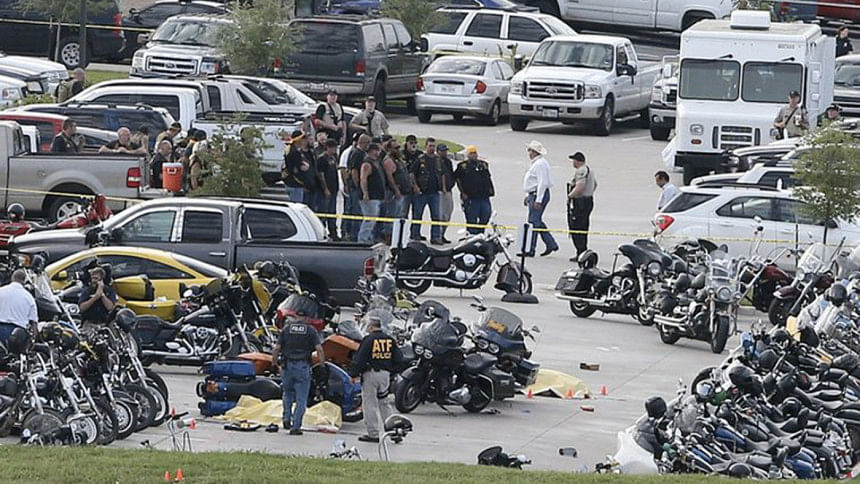Analysis: Behind the Waco biker gang shootout

A shootout between three rival biker gangs at a bar in Waco, Texas, on Sunday afternoon left at least nine gang members dead. Eighteen others were taken to the hospital with gunshot and stab wounds, the Associated Press reports.
The news site Vox, reports an analysis by an undercover agent who explains dynamics of biker gangs and its raising trend in the US.
Texas is an emerging battleground for outlaw motorcycle gangs, said Steve Cook, executive director of the Midwest Outlaw Motorcycle Gang Investigators Association. Next month, Cook, who works in law enforcement in Kansas City and worked undercover in a motorcycle gang in the early 2000s, was supposed to travel to Waco to hold a conference for local police.
Waco historically hasn't been a hot spot for gang rivalries, Cook said. In a 2013 national survey of law enforcement, Texas didn't show up as an area of intense gang activity. But in an interview Sunday night, Cook said he knew something was coming: "We were pretty certain that some kind of incident was on the horizon."
Outlaw motorcycle gangs are a small slice of gang activity in the US.
Motorcycle clubs have been accused of lawlessness since at least 1947, when a Fourth of July motorcycle race in Hollister, California, got national attention for drunkenness and disorder and became the inspiration for the 1953 Marlon Brando movie The Wild One.
An enduring pattern was set: motorcycle gangs were both a perceived larger-than-life menace and an object of media fascination. The Hell's Angels were excoriated by the California attorney general in 1965 and infiltrated by gonzo journalist Hunter S. Thompson.
Violent motorcycle gangs call themselves the "1 percent" — a defiant reference to a (possibly apocryphal) statement from the American Motorcycle Association that 99 percent of motorcyclists are law-abiding. There are hundreds of motorcycle gangs in the US, but the Department of Justice considers eight national groups to be a serious threat.
The gangs, which originated in the US but have spread abroad, are best known for trafficking in drugs and sometimes people.
But they're a relatively small part of the American gang landscape. A 2013 survey from the National Gang Intelligence Center found that about 2.5 percent of gang members nationwide are in outlaw motorcycle gangs.
All the same, police consider them to be more threatening than their small numbers might suggest. About 10 percent of jurisdictions said they considered the motorcycle gangs a serious threat.
Cook thinks that law enforcement should be more concerned. "I think a lot of people just don't take these guys seriously," he says. "They just look at them and say they're bikers and they ride motorcycles and they're tattooed and they're dirty, and that's the end of it."
But he calls them domestic terrorists. "They can pretend like they're these fraternal organizations," he said. "I can't tell you the last time the Kiwanis and the Shriners had a shootout at a public venue."
The Department of Justice portrays the gangs as the Mafia on motorcycles, saying they traffic in cocaine, methamphetamine, and prescription drugs: in Indianapolis in 2013, federal agents arrested 42 members of the Outlaws gang on charges that included drug trafficking, extortion, and money laundering.
Clashes occur when biker gangs fight over territory
A nine-year battle in Canada between rival gangs, known as the Quebec Biker Wars, left 160 people dead. In California in 2010, biker gangs fought over who would control a Starbucks in Santa Cruz, which led to gang members hitting each other with hammers in the parking lot.
Cook said Texas hasn't historically been a hotspot for this kind of battle – at least, no more than anywhere else. But he said he'd seen signs that a confrontation was coming. Texas, he said, has historically been controlled by the Bandidos, one of the largest outlaw motorcycle gangs in the US.
At least five motorcycle gangs comprising 150 members were meeting at the Twin Peaks bar and restaurant in Waco to discuss recruitment. Local officials haven't yet said which gangs were involved in the shooting.
The Cossacks, a local Texas gang, had been challenging the Bandidos' dominance, including discussing a possible alliance with the Hell's Angels, a rival of the Bandidos, Cook said.
The biggest provocation came when the Cossacks began wearing a Texas patch on their clothing – "basically a slap in the face to the Bandidos," said Cook, who says he was an undercover investigator of the Bandidos and some of their support groups.
"We knew the tensions with the Cossacks were as high as they'd ever been," he said. "I don't think anybody could have forecasted it to the degree that it happened."

 For all latest news, follow The Daily Star's Google News channel.
For all latest news, follow The Daily Star's Google News channel. 



Comments